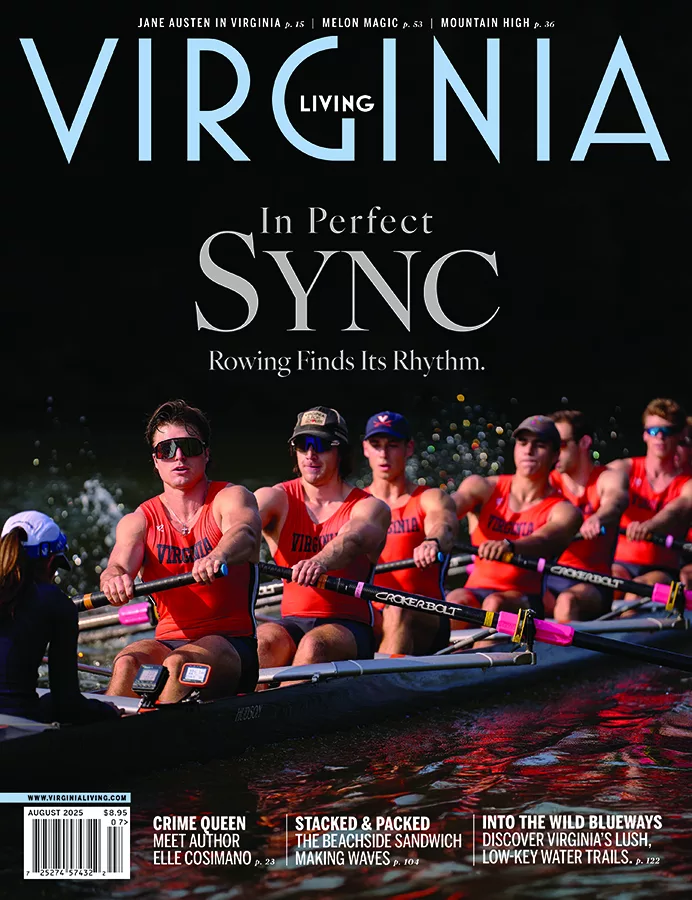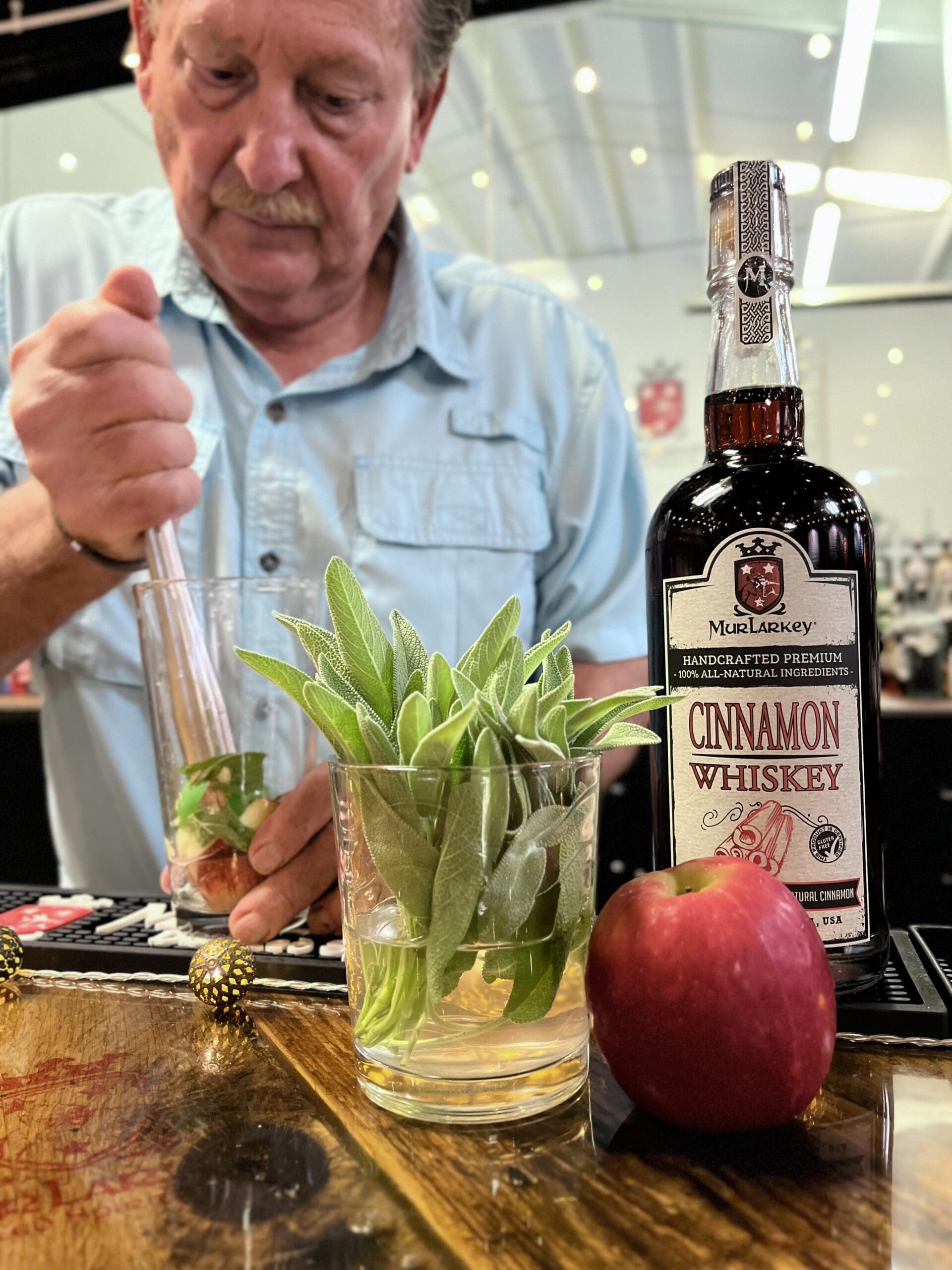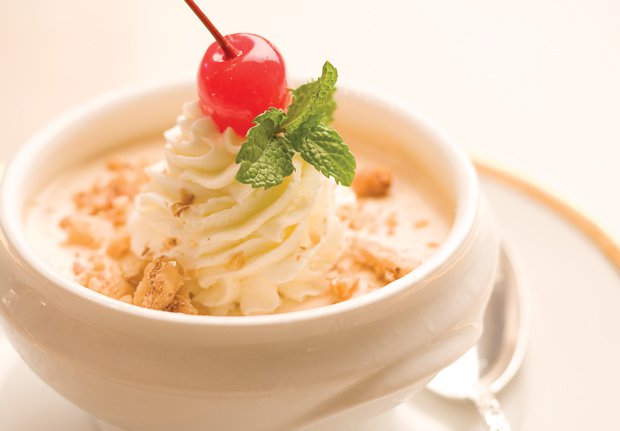

Vintage Virginia Apples owners Chuck and Charlotte Shelton
Oh, Golden Delicious, Granny Smith and Fuji. You were the loves of my youth. Honeycrisp and Gala, Red Delicious and Braeburn, you nourished me, filled me with pleasure, even, if the old saw is to be believed, kept me healthy. But are you enough? Not any more. Estimates of the number of apple varieties in the American market alone are in the thousands, 1,000 to 2,000 of which are heirloom varieties. Of all the varieties still grown in Virginia, vintage types number around 500. Some of the best are the oldest, and heirloom varieties—many with quirky names like Winter Banana and Northern Spy—are finding their way to homes and restaurants that heretofore clung to the more readily available dozen or so varieties bought from grocery chains or shipped great distances by wholesalers. Although you can’t yet find them in grocery stores, heirloom apples are regaining a prominent profile, driven by the explosion of farmers’ markets around the country andthe ease of online shopping.
Let’s face it. Apples go way back. (Ever wonder what tasty flavor captivated Eve in the Garden of Eden?) The eastern slopes of the Blue Ridge and the valley of Virginia have been among the greatest apple-growing regions in the world since Colonial times. Early settlers planted the trees not only for food but largely for cider production. Thomas Jefferson experimented with some 18 varieties at Monticello. And it wasn’t long before varieties emerged as individually noteworthy products—many during Jefferson’s lifetime. Today, apples with a history are a precious delicacy. Of the 5.5 million bushels now produced in Virginia each year (the Albemarle Pippin topping the list of most desired), the Virginia Department of Agriculture estimates that only 5,000 to 10,000 bushels are heirloom varieties.
Sadly, these homegrown gems slimly survived the 20th century. Apples were in their heyday in the 1860s; so much so that they were overproduced, according to Lynchburg resident and apple expert Tom Burford, author of Apples: A Catalog of International Varieties (2004). (His next book, Apples of America, being published by Timber Press, is due out next year.) Moving into the 20th century, creeping suburbanization flattened many orchards. Then in the 1950s, when markets were becoming “super” markets, heirloom apples fell into obscurity, supplanted by prettier, mass-farmed apples that could withstand the harsh conditions of shipping and sitting in grocery store bins for days at a time. “Thirty or 40 years ago, there was the Red Delicious and the Golden Delicious,” says Burford, whose family began producing fruit on the slopes of the Blue Ridge in 1715.
“It was said that it would have to be pretty because the consumer isn’t going to buy anything that looks different,” explains Burford. “Along comes Granny Smith to prove them wrong.” Once imports like Fuji (developed in Japan by crossbreeding Red Delicious and Virginia’s Ralls Genet), Gala and Braeburn hit the market, consumers wanted more choices. “For the first time, the consumer asked ‘What else have you got?’” says Burford. Now sated on various imports from around the world, the consumer asks again, what else? And the answer is the heirloom apple. Burford notes that more and more orchards are beginning to plant vintage varieties. “What we are doing now is re-inventing the apple culture,” he says.
“We are now at the point where they are appearing at farmers’ markets, where many of them have been re-introduced,” says Burford, whose firm Burford Brothers grew and marketed hundreds of varieties of heirloom and modern fruit trees until 1997 when Burford decided to grow the education component of the business. Now he travels the U.S. conducting workshops and seminars on growing and marketing apples.
Those who know heirloom apples say that many old-timey varieties just flat out taste better. “A lot of [heirloom] apples have much more vibrant flavors than what we get in the commercial market,” says Charlotte Shelton who, with her siblings, owns Vintage Virginia Apples, a 10-acre orchard in North Garden that began operating in 2000. But trends like slow food and green food are as much motivators for vintage apple consumption as simple enjoyment. “As a culture, we’re getting more interested in our food sources,” Shelton says. “We find that people are a lot more interested in foods that are not so homogenized.” The Sheltons, who got into the orchard business as a hobby, sell only about 1,000 bushels of their 250 heirloom varieties each year. The bulk of their business comes from selling heirloom apple trees to private growers and orchardists.
Generally speaking, vintage apples won’t win any beauty contests. They tend not to look like those shiny, rich-hued, perfectly shaped modern versions that we find at the grocery store. Depending on the variety, “dull,” “squatty,” and “lopsided” are some of the nicer adjectives used to describe the antiques. “It’s sad that people say they want one of those unblemished, smooth-skinned Golden Delicious that have half the flavor [of a vintage apple],” says Burford, who is known as Professor Apple at Monticello where he has been a consultant for 29 years. Fortunately for vintage apple producers, people now seem to buy for flavor rather than looks. “I think there’s a movement [away] from buying food with our eyes,” Shelton says. Burford credits farmers’ markets with raising awareness of these ugly, older apples. “They’re offering tastings,” he says. “People will have a taste of the apples and say they don’t care how it looks.”
Not every heirloom is prized for its taste. Some varieties are destined to be turned into cider. “Just like you wouldn’t put a wine grape on the table,” notes Shelton, “you wouldn’t want to eat some apples that are good for cider.” Burford estimates that some 300 varieties are just for making cider. “There’s a misconception that, because it’s vintage, it tastes good,” he says. “Ninety percent are quick spitters.” Huh? “You take one bite and spit it out.”
According to Burford, the demand for some eating varieties outstrips the supply, led by the Albemarle Pippin, Black Twig and Arkansas Black. “People can’t get enough of them,” he says. The Pippin, also known as the Newtown Pippin, has been a standout since the early days of America. Thomas Jefferson dispatched this from France: “They have no apple to compare with our Newtown Pippin.” And when Queen Victoria was presented with two barrels of Pippins by England’s American ambassador in 1838, she was so taken that she lifted the import tax on that variety.
While antique apples are making a small splash in the marketplace, there’s plenty of room to grow. In Virginia, 6th in the country for apple production, small, private growers are leading the way in re-introducing heirloom varieties. The trend to revert to simple, non-homogenized foods has primed the market. “Today, we’re trying to get back to food the way it was back in the 1930s and ’40s.” That, Burford says, will have an enormous impact on the growth and acceptance of the vintage apple.
Says Burford: “One could say they are here to stay.”
Where to Find Heirloom Variety Apples in Virginia
Dickie Brothers Orchard
Nelson, 434-277-5516
DickieBros.com
Stayman, Winesap, Rome
Graves Mountain Farm
Syria, 540-923-4231
GravesMountain.com
Stayman, Winesap, Rome, York
Hartland Orchard
Fauquier, 540-364-2316
HartlandOrchard.com
Grimes Golden, Cortland, Jonathan,Smokehouse, Winesap, Rome
Ikenberry Orchards
Botetourt, 540-992-6166
IkenberryOrchards.com
Jonathan, York, Winesap,Stayman, Rome
Vintage Virginia Apples
North Garden, 434-297-2326
VintageVirginiaApples.com
Arkansas Black, Bishop, Pippin
Marker-Miller Orchards
Winchester, 540-662-1391
MarkerMillerOrchards.com
Rambo, Jonagold, Rome, Stayman, York
Morris Orchard
Monroe, 434-929-2401
MorrisOrchard.com
Stayman, Winesap, York,Arkansas Black, Albemarle Pippin
Richard’s Fruit Market
Middletown, 540-869-1455
RichardsFruitMarket.com
Jonathan, Grimes Golden, Stayman, Rome
Showalter’s Orchard and Greenhouse
Timberville, 540-896-7582
ShowaltersOrchardandGreenhouse.com
Rome, Winesap, York, Arkansas Black
Urban Homestead
Bristol, 276-466-2931
OldVaApples.com
Gilpin, Lowry, Red Horse, Seek-No-Further, Henry Clay, Ladyfinger, Reasor Green
Both Shelton and Burford note that the sometimes quirky names of vintage apples add to their appeal. Here are just a few vintage varieties that sprung up in the eastern half of the country in the 18th and 19th centuries:
Ben Davis
A 19th-century staple; the most widely plantedapple variety in the South after the Civil War;large, dull red.
Smokehouse
Originated in the early 1800s; mild flavor; juicy;flattish shape with red and green stripes; crisp and tender; good for cooking.
Winter Banana
First appeared in the mid-1800s; also known as Banana and Flory; large, round; pale yellow skin with a rosy blush; crisp and juicy, and unusually aromatic.
Summer Rambo
First recorded in 1535 in France; also called Lorraine and Rambout Franc; large and lightly ribbed with pale greenish-yellow skin, flushed with pale red and streaked carmine, scattered with russet patches;firm flesh with a slightly sweet flavor.
Northern Spy
Discovered around 1800; Believed to have originally been called Northern Pie; also known as Red Spy and Red Northern Spy; large, streaked with a clear, yellow shade and a bright red tint; juicy, crisp and tender; high sugar content makes it a goodcandidate for hard cider.
Northwestern Greening
Originated in 1872; big, green; good for pies; tough skin; firm, juicy and mildly tart.
Woodpecker
Discovered in 1750; also called Baldwin and Butters apple; once the third most popular in the U.S.; tough skin, yellow with red; crisp, tender and sub-acid; stores well.
Winesap
One of the more common vintage varieties; also called American Wine Sop for its wine-like flavor; originated around 1817; stores well.
Stayman
Another of the more common vintages; also a wine-like essence; discovered at the home of Dr. J. Stayman in the mid-19th century.
Rome
Also known as Rome Beauty, Starbuck and Gillett’s Seedling; first discovered in 1816.
Paradise
Also known as Paradise Sweet; originated in the early 1800s.
Northwest Greening
Discovered in 1872; a cross between Golden Russet and Alexander; green, good for pies.
Cortland
Introduced in 1898 by the New York StateExperiment Station; a cross between McIntoshand Ben Davis.
Jonathan
Introduced in 1820; eventually became the sixthmost popular variety in the U.S.
Abram
First noted in a Virginia newspaper in 1755;greenish-yellow skin shaded with dull red; flavor improves during storage; good for cider-making.
Arkansas Black
Originated in 1870; dark red, almost black;improves in flavor in storage.
Calville Blanc
Also known as Calville Blanc d’Hiver or WhiteWinter Calville; classic French dessert apple dating to the 16th century; large, oblong with pale greenor yellow skin with a pale red blush.
Maiden’s Blush
Originated in 1817; also known as Lady Blush and Red Cheek; sharp, tangy flavor, suited for cooking and, when fully ripe, for eating.
Virginia Pilot
Originated in 1830; disappeared and re-discovered by Tom Burford in 1989; large, roundish; pale yellow skin striped and shaded with dull red.
This article originally appeared in our October 2011 issue.









